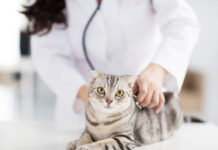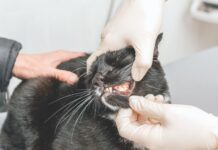I receive many questions about feline leukemia virus (FeLV) testing, particularly as it pertains to kittens, so Ive decided to veer from the one question, one answer format by making a list of FAQs (frequently asked questions). Here goes.
If a mother cat is infected with FeLV, will all her kittens be infected?
Not necessarily. Some of the kittens will become infected in utero – in the womb – and often they are miscarried. The in utero-infected kittens that are born alive may be unhealthy from the start and succumb early in life. But kittens escaping in utero infection arent out of the woods yet; they can get infected through the milk as they nurse or from the mothers saliva as she licks them clean. Kittens infected in utero will test positive from the outset, but those infected through the milk or saliva may not test positive for six weeks or longer after birth.
If a mother cat tests negative for infection, can she still infect her kittens?
Counterintuitive though it may be, the answer is yes. Because of the insidious way FeLV works, its possible for a mother cat that was once infected but was able to rid virus from her bloodstream – and currently tests negative – to have kittens that are infected.
I work in an animal shelter, and we routinely test our cats for FeLV. We frequently receive mother cats and their litters, and it would save us a great deal of money if we could test only the mom or just one of the kittens. Can we get away with that?
Unfortunately, no. Test results from one kitten in the litter or just the mom cant predict the results in the other cats. You need to test the mother and all the kittens.
Can positive-testing cats become negative over time, or will they always test positive?
Depending on the type of test used, some cats will test positive for virus in the bloodstream for a short period of time, usually less than 12 weeks, and then go negative. This is much more common with enzyme-linked immunosorbent assays (ELISA) or similar tests – the common in-house screening tests – than with indirect immunofluorescent antibody (IFA) tests because of the different stages of infection each test is capable of detecting. To confirm the true infection status of a cat that tests positive on an in-house test, my favorite option is to immediately test with an IFA. If both the ELISA and IFA results are positive, then it is highly likely that the cat is currently infected, will always be infected, and is contagious to other cats. On the other hand, if the IFA comes back negative, then I suggest keeping the cat away from other cats and rechecking both ELISA and IFA in about six weeks. By that time, about half of the cats will either be positive on both tests (meaning theyre infected) or negative on both tests (the best news) although a few will continue to have positive ELISA and negative IFA results indefinitely.
I just adopted a cat and he tested negative. Can I breathe a sigh of relief and let him mingle with my other cats?
Perhaps a little sigh, but not a big one. What if your cat was exposed just a few days before you adopted him? It takes a while after exposure to FeLV – a month or longer with an ELISA and up to 12 weeks with an IFA-for the tests to become positive. I prefer to test right away; if the result is positive, then follow the guidelines mentioned previously. If, like in the case of your cat, the result is negative, my preference is to keep the cat away from others and retest no sooner than a month to six weeks later with an in-house test. A negative result on that test is the go-ahead sign that your cat is not infected and he can safely mingle with the others.
Someone told me that positive ELISA results should always be confirmed with an IFA. Is this true?
Yes, thats my preference. I like to use an ELISA-type test as screening tests, then follow up with an IFA test if the result is positive. Negative ELISA tests usually dont require confirmation with an IFA.



